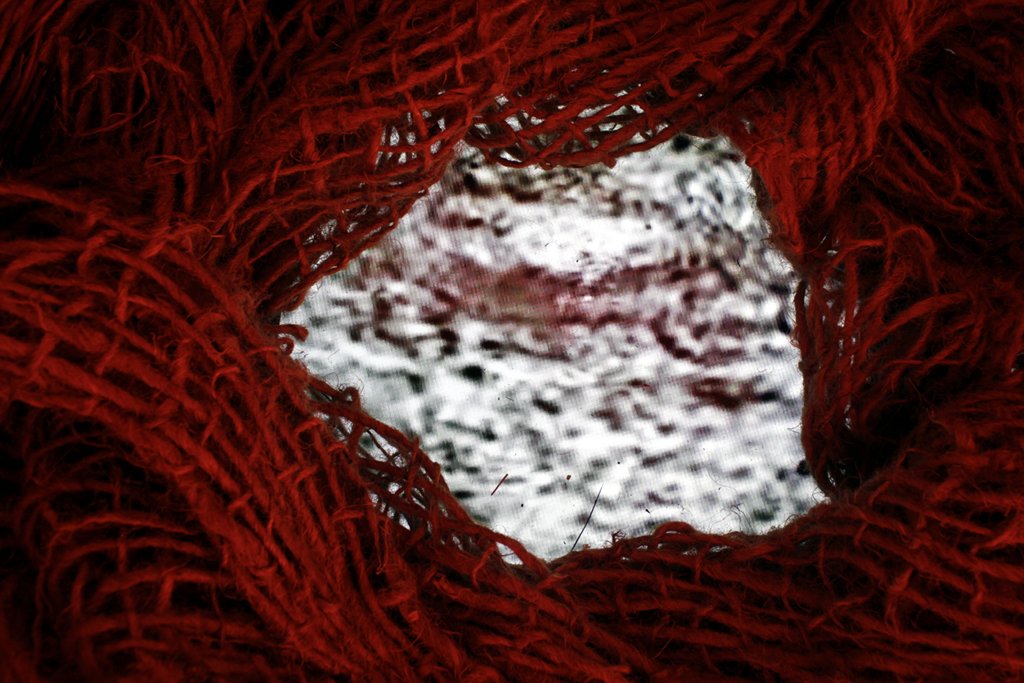schwärmen + vernetzen (2017)
Transdisciplinary artistic research project and installation. 108-channel sound; 3+1 channel video; text composition; objects and spatial structures; light; odor. Sound composition: Hanns Holger Rutz. Visual composition: Nayarí Castillo. Text: Gertrude Grossegger. Video: Hanns Holger Rutz and Nayarí Castillo. Research partner: Artificial Life Lab, Graz. Exhibition: Akademie Graz, Austria, autumn 2017.
schwärmen + vernetzen” (swarming and networking) explores the possibilities of transdisciplinary work in art, realising them through forms of “movement profiles”, retracing the vacating of individual viewpoints of the participating artists and the emergence of joint forms of movement. In order to make novel connections between text, visual elements and sounds possible, the three artists put themselves into an experimental arrangement, topically structured around dynamical systems of swarming and networking, originating from biology; we are interested in systems in which new organisms develop without dissolving their partial structures, individual media, and individual scopes of work. At the centre of the project was an installation with sound, text, objects, light.




The spatial development of the collaboration extends itself across the room. Red light showers a compendium of fishing-traps of all latitudes, nets, antique beehives, strings and other natural materials, which are put together in a hazardous system that sustains 600m of cable interconnecting the 108 speakers, a conglomerate that grows naturally and elevates through massive metal supports. Each of the three branches relates to the spinal cord making visible the almost painful joints. The strange drawn animal has a singular skin, full of ocellated structures of beeswax, the entire surface of which introduces a key element to the overall experience: odour. This conformation is different and in its strangeness allows itself to be an unconcerned sculptural gesture, a formation as harmonious and disharmonious as natural growth that at the same time exposes the synergies explored during the process by the artists’ think tank.




schwärmen + vernetzen (room rec.)
The sound installation is based on the contact between two spatial networks—one is the physical topology of the arms of the entity with a set of possible paths of traversing them. The other is a latent space created by an arrangement of the spoken recording of Grossegger’s text “laufende rhythmen”, segmented into words and phrases following the particular dynamic of the reading. Main sections of the text (“da dreht sich…”, “ich fahre jetzt…”, “und mehr und weiter…”) were assigned to beehives demarcating the extremities within the space. For each pair of hives, a complete graph was formed with all pairwise segments connected through their acoustic similarities. The millions of edges are subsequently reduced by an algorithm called “minimum spanning tree” that builds pathways between all segments (words and phrases) of the paired text sections. The beehives, inside of which the text sections are projected in their original sequentiality, rhythmically negotiate movements between one another, each time departing from the currently visible word or phrase, and then traversing the latent graph, with each node moving along the physical space, audible also by the mechanical switching relays which form a sort of nervous system in the centre of the room. By relying on the acoustic properties of the spoken words, a balance is created where new rhythms may arise as pure sound in the space. Artefacts in the original recording taken at a retreat in St Lambrecht, such as bird sounds, wind, a church bell, are preserved. Where the voice is absent, a multitude of faint sounds of buzzing bees appear.




The project was funded by Kulturamt der Stadt Graz, Kulturreferat des Landes Steiermark, and Bundeskanzleramt Österreich - Sektion für Kunst und Kultur.
Further Formats
- An extensive bilingual catalogue has been published (Reagenz Verlag, ISBN 978-3-9504622-0-3). It documents the research process, the exhibition, and contains novel text experiments and contributions by Nayarí Castillo, Gertrude Grossegger, Asya Ilgün, David Pirrò, Nicole Pruckermayr, Hanns Holger Rutz. Please contact us if you would like to obtain a copy.
- The development process of the installation has been documented on the Research Catalogue.
- The project is documented in Lichtungen No.151/2017.
- We have published a video trailer.